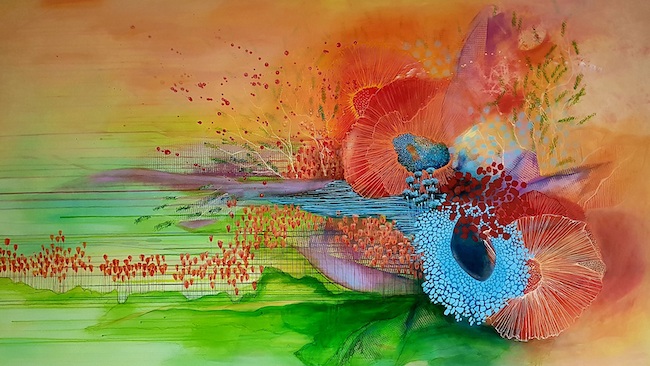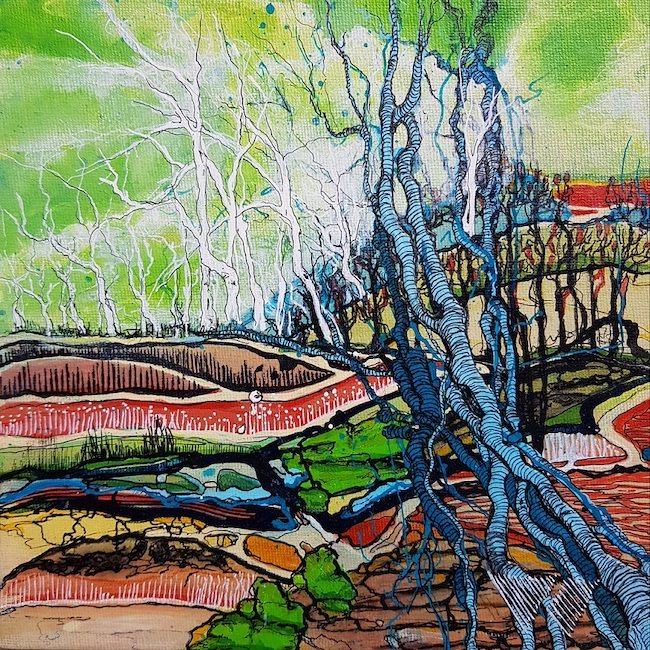Nel vivere contemporaneo si tende spesso a sottovalutare l’esigenza innata e primordiale di mantenere un più stretto contatto con la natura, quel mondo all’interno del quale è possibile connettersi con la parte più pura di un sé impegnato a muoversi in una quotidianità fatta di impegni a cui far fronte, di contingenza di cui occuparsi e di una fretta di vivere, ottenere, accumulare, che distoglie da un contatto più profondo e introspettivo. Esistono però alcuni artisti che tendono a enfatizzare quella necessità di ritrovare un percorso verso la vera essenza dell’individuo, quella che può fuoriuscire riavvicinandosi alla spontaneità e alla semplicità che proprio la natura, quel circostante che solo distrattamente viene osservato, riesce a donare. La protagonista di oggi affronta personalmente quel percorso e lo trasforma nella base di tutta la sua produzione artistica.
La natura nella storia dell’arte ha sempre avuto un posto rilevante, sebbene a periodi alterni le sia stata preferita la raffigurazione ritrattistica di nobili e personaggi dell’alta società, oppure di icone religiose; in alcune culture addirittura ha costituito la base e l’essenza delle manifestazioni creative di un intero popolo. Il Giappone ha sempre posto in primo piano la raffigurazione dei magnifici fiori di ciliegio, dei luoghi magici e dei fenomeni naturali come nel caso della celeberrima Onda di Hokusai, e ciascun elemento descritto racchiudeva in sé una simbologia intensa e rappresentativa del legame del popolo giapponese con la natura che lo circonda. Ma anche nell’Europa di fine Ottocento emergeva la necessità di staccarsi dagli ambienti chiusi del ritratto per ritrovare il piacere di lasciar vagare l’occhio verso l’esterno, verso la luce e i colori che hanno contraddistinto l’inconfondibile stile dell’Impressionismo, dove però la predilezione era per il paesaggio, per la riproduzione di istanti, impressioni appunto, di scorci di visioni che potevano essere più ristrette come nelle Ninfee oppure più ampie come nell’opera Impressioni du soleil levant, entrambi di Claude Monet. Parallelamente all’Impressionismo, tra fine Ottocento e inizi Novecento andò affermandosi l’Art Nouveau che enfatizzò in maniera ancor più incisiva l’utilizzo di elementi naturali e soprattutto floreali per decorare non solo complementi d’arredo e oggetti d’artigianato bensì anche per permettere all’arte di avere una valenza puramente estetica, legata alla gioia di vivere della Belle Epoque, in cui trovare il piacere di osservare un oggetto senza doverne interpretare il significato. Tanto orientati alla considerazione del bello, della piacevolezza e della perfezione espressiva furono Impressionismo e Stile Liberty quanto invece protési verso la manifestazione interiore anche attraverso la narrazione di paesaggi e di fenomeni atmosferici più o meno impetuosi che dovevano accordarsi agli stati d’animo dell’autore dell’opera furono gli artisti aderenti all’Espressionismo, uno fra tutti Vincent Van Gogh. L’artista Vera Weber, nata nella Russia siberiana ma residente in Germania da moltissimi anni, fa suo il tema floreale tipico dell’Arte Giapponese e dell’Art Nouveau, che però non limita alla pura espressione estetica bensì lo rende base di partenza per un sentire profondo e intenso, una modalità per liberare la parte istintiva e personale che si manifesta attraverso forme di piante immaginarie, e qui in qualche modo la sua arte si avvicina al Surrealismo per quel liberare la fantasia generando un mondo simile a quello reale e tuttavia distante perché appartenente alla dimensione del sogno.
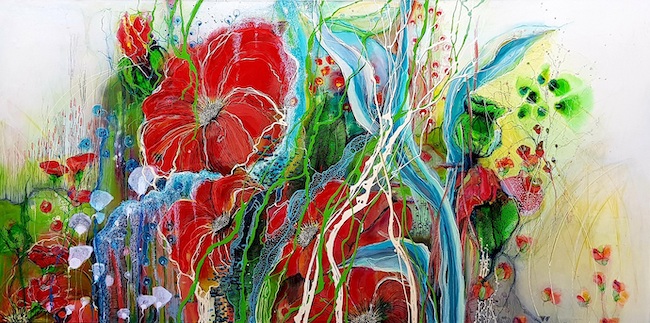
Non solo, ciò che contribuisce a sottolineare l’approccio interiore e liberatorio della sua arte sono i colori con cui racconta le immagini e che divengono legame imprescindibile con le emozioni che, di volta in volta, decide di imprimere sulla tela. Dunque l’Espressionismo delle tonalità scelte, volutamente innaturali per sottolineare quanto il mondo descritto appartenga al sentire profondo, alle sensazioni che la Weber evidenzia attraverso i titoli per indurre l’osservatore a riflettere sulle proprie debolezze, sulle emozioni che spesso sceglie di non considerare perché fuorvianti rispetto al binario retto e schematico su cui ha preferito basare la sua esistenza. Eppure, sembra dire Vera Weber, l’essere umano non può prescindere dalle proprie pulsioni interiori, dall’innata inclinazione a effettuare prima o poi un cammino più introspettivo ed è quello il momento in cui lasciar uscire i propri veri colori, quelli dell’interiorità attraverso cui prendere coscienza dei bisogni e dei timori spesso inconfessati.
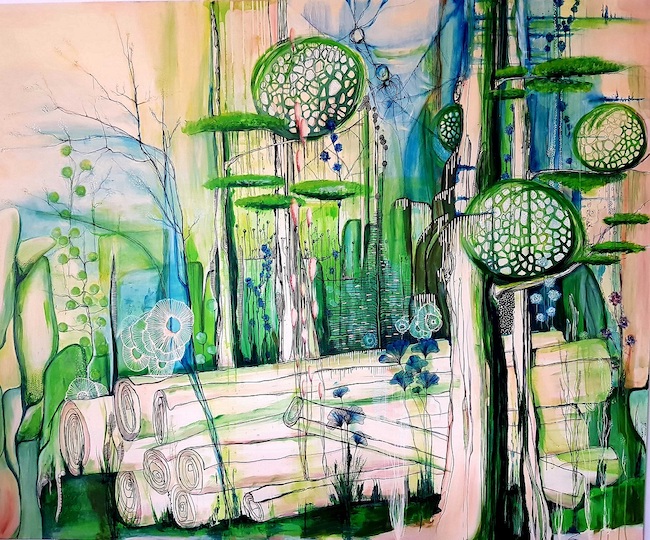
Nella tela Forest Wisdom (Saggezza della Foresta) l’artista esplora il tema della consapevolezza, della memoria della natura in grado di conservare tutto ciò che è necessario all’evoluzione delle specie che la abitano; l’elemento del ricordo è rappresentato da quei grandi cilindri che sembrano essere papiri arrotolati all’interno dei quali si conserva la storia, il percorso, il passaggio del tempo su cui si incidono esperienze, cambiamenti, modificazioni, metafora della costante evoluzione non solo delle epoche bensì anche dell’essere umano che a quelle epoche si adegua, a volte cercando di diventarne regista, sebbene la saggezza della natura sia consapevole che in realtà ne è solo comprimario.
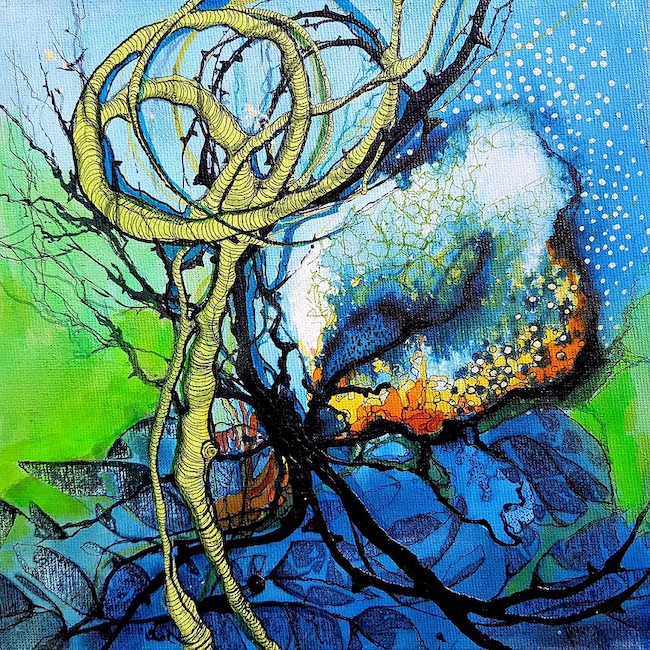
Nella serie di opere intitolate Fragility (Fragilità) Vera Weber mostra tutta la sua attitudine al Surrealismo raccontando di fiori e di piante appartenenti a un futuro ipotetico in cui l’uomo ha dimenticato l’importanza di nutrire e coltivare la natura intorno a sé, non l’ha protetta generando un inaridimento, una fossilizzazione che le ha fatto perdere tutta la vitalità, tutta quella vita che avrebbe mantenuto inalterata se non fosse intervenuto l’uomo con il suo atteggiamento noncurante e poco lungimirante.
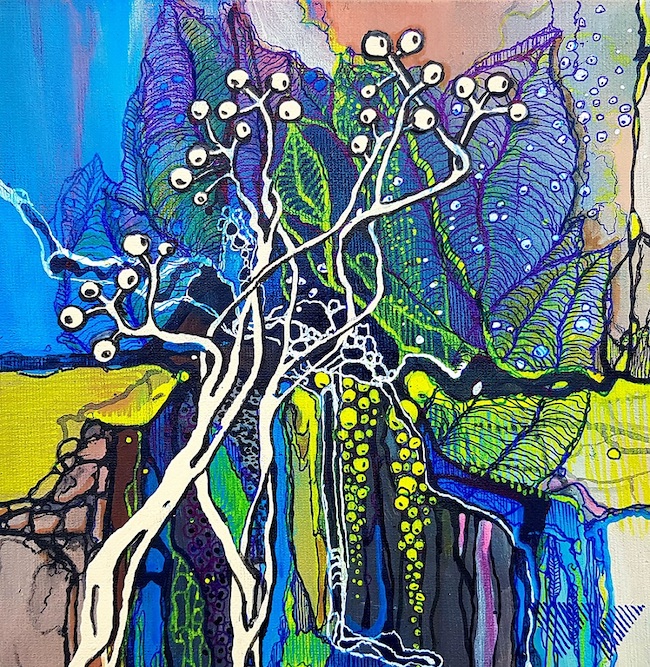
Eppure, malgrado ciò che appare esternamente esiste ancora vita sotto quella reazione di autodifesa dei tronchi inariditi, degli steli senza fiori, c’è ancora la possibilità di recuperare e trovare un modo per rigenerare ciò che è stato perduto, e di infondere nuovi colori a ciò che si è trasformato in tonalità più spenta pur volendo ricominciare a pulsare.
In fondo quella narrata da Vera Weber è la metafora dell’uomo contemporaneo, quel trascurare di coltivare la semplicità e la naturalezza per prediligere l’arrivismo e l’accumulo di beni materiali incapaci, sulla lunga distanza, di dare la felicità. Felicità che il delicato animo umano riesce magicamente a raggiungere quando si pone in connessione con un esterno che, secondo l’artista, è in grado di sollecitare le sensazioni più vive, pure, immediate, riportando l’individuo verso l’attitudine originaria a non cercare troppo distante da sé, da ciò che in realtà si è allontanato solo a causa di un distacco dal lato fanciullesco che però permane latente, in attesa di poter essere di nuovo ascoltato.
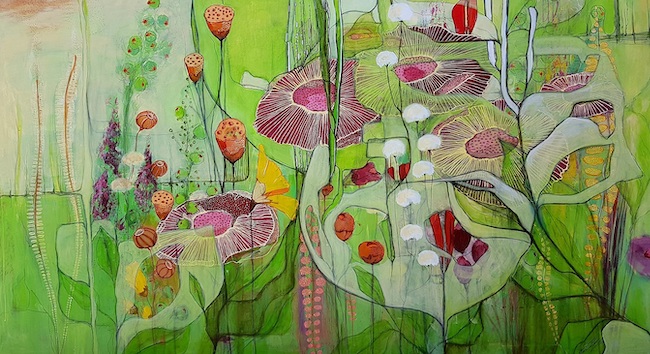
L’immediatezza e la bellezza dei fiori, mescolata alla capacità della Weber di delineare sottilmente i confini tra quanto appartiene a una visione quotidiana, familiare, e quanto invece si lega all’immaginario, al sogno, conduce l’osservatore verso un mondo fiabesco all’interno del quale tutto può assumere un significato differente ma che in ogni caso rasserena, distende, induce a lasciarsi trasportare al suo magico interno; questa è la sensazione che si riceve osservando la tela Grüne Wise (Prato verde) dove i fiori appaiono come un soffice mondo pronto ad accogliere chiunque senta l’esigenza di perdersi al suo interno senza temere una sembianza differente da quella che ci si aspetterebbe, anche questa metafora dell’uomo contemporaneo costantemente in bilico tra la tendenza a uniformarsi e a osservare la realtà dal punto di vista generalizzato oppure scegliere di uscire dal coro e andare oltre il modo in cui la società desidera che le cose vengano osservate. È solo compiendo una scelta coraggiosa che sarà possibile trovare ristoro e conforto in quel mondo parallelo a quello coperto da cemento e asfalto, quel mondo accogliente nella sua spontaneità che può costituire il nido di un nuovo essere umano, più sensibile, più empatico, concetto che l’artista sottolinea attraverso l’opera Nest (Il nido).
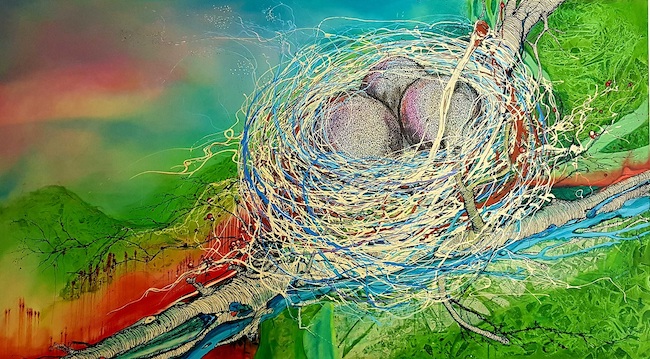
Vera Weber, artista, disegnatrice, illustratrice, tiene corsi di pittura e di illustrazione nel suo atelier e partecipa regolarmente a mostre collettive in Germania.
VERA WEBER-CONTATTI
Email: kontakt@vera-weber-art.de
Sito web: www.vera-weber-art.de
Facebook: https://www.facebook.com/vera.weber.5205
Instagram: https://www.instagram.com/vera_weber_art/
The magical combination of emotions and nature in the artworks of Vera Weber
Contemporary life often tends to underestimate the innate and primordial need to maintain closer contact with nature, that world within which it is possible to connect with the purest part of a self that is busy moving through a daily routine made up of commitments to cope with, contingencies to deal with and a haste to live, obtain, accumulate, which distracts from a deeper and more introspective contact. There are, however, some artists who tend to emphasise the need to rediscover a path towards the true essence of the individual, that which can emerge by reconnecting with the spontaneity and simplicity that nature itself, that surrounding which is only distractedly observed, is able to give. Today’s protagonist personally tackles this path and transforms it into the basis of her entire artistic production.
In the history of art, nature has always had an important place, even if at different times it has been preferred the representation of portraits of nobles and high society figures, or religious icons; in some cultures it has even constituted the basis and essence of the creative manifestations of an entire people. Japan has always placed in the foreground the depiction of magnificent cherry blossoms, magical places and natural phenomena, as in the case of Hokusai’s famous Wave, and each element described contained an intense symbolism representing the bond between the Japanese people and the nature that surrounds them. But even in late nineteenth-century Europe there was a need to break away from the closed spaces of the portrait to rediscover the pleasure of letting the eye wander outside, towards the light and colours that distinguished the unmistakable style of Impressionism, where, however, the preference was for the landscape, for the reproduction of instants, impressions, glimpses of visions that could be more restricted as in the Water Lilies or wider as in the work Impressions du soleil levant, both by Claude Monet. In parallel with Impressionism, the late 19th and early 20th century saw the rise of the Art Nouveau style, which emphasised even more the use of natural and especially floral elements to decorate not only furnishings and handicrafts but also to allow art to have a purely aesthetic value, linked to the joie de vivre of the Belle Epoque, in which one could find pleasure in looking at an object without having to interpret its meaning. So much oriented towards the consideration of beauty, pleasentness and expressive perfection were Impressionism and Art Nouveau as the artists who adhered to Expressionism, one between all was Vincent Van Gogh, were interested in interior manifestation also through the narration of landscapes and more or less impetuous atmospheric phenomena that had to accord with the author’s moods.
The artist Vera Weber, who was born in Siberian Russia but has lived in Germany for many years, takes up the floral theme typical of Japanese Art and Art Nouveau, even if she does not limit it to pure aesthetic expression but makes it the basis for a deep and intense feeling, a way of freeing the instinctive and personal side that manifests itself through imaginary plant forms, and here in some ways her art comes close to Surrealism for its freeing the imagination, generating a world similar to the real one and yet distant because it belongs to the dimension of dreams. Not only that, but the colours with which she depicts her images and which become an inseparable link with the emotions she decides to imprint on the canvas from time to time, help underline the interior, liberating approach of her art. Thus the Expressionism of the shades chosen, deliberately unnatural to underline how much the world described belongs to deep feeling, to the sensations that Weber highlights through the titles to induce the observer to reflect on his own weaknesses, on the emotions that he often chooses not to consider because they are misleading compared to the straight and schematic track on which he has preferred to base his existence. And yet, Vera Weber seems to say, human beings cannot ignore their inner drives, their innate inclination to take a more introspective path sooner or later, and this is the moment in which to let come out their true colours, those of their interiority through which they become aware of their often unconfessed needs and fears.
In the canvas Forest Wisdom the artist explores the theme of awareness, of the memory of nature capable of preserving all that is necessary for the evolution of the species that inhabit it; the element of memory is represented by those large cylinders that seem to be rolled-up papyruses inside which history is preserved, the path, the passage of time on which experiences, changes, modifications are engraved, a metaphor for the constant evolution not only of epochs but also of the human being who adapts to those epochs, sometimes trying to become their director, although the wisdom of nature is aware that in reality he is only a supporting actor. In the series of paintings entitled Fragility, Vera Weber shows all her aptitude for Surrealism by telling of flowers and plants belonging to a hypothetical future in which man has forgotten the importance of nourishing and cultivating nature around him, has not protected it, generating a drying up, a fossilisation that has caused them to lose all their vitality, all the life that they would have maintained if man had not intervened with his careless and short-sighted attitude.
And yet, despite what it looks like from the outside, there is still life underneath that self-defence reaction of the parched trunks, of the flowerless stems, there is still the possibility of recovering and finding a way to regenerate what has been lost, and of infusing new colours into what has turned into a duller hue despite wanting to start pulsating again. In the end, the story told by Vera Weber is a metaphor for contemporary man, who neglects to cultivate simplicity and naturalness in favour of careerism and the accumulation of material goods which are incapable of bringing happiness in the long term. Happiness that the delicate human soul magically succeeds in attaining when it connects with an exterior which, according to the artist, is capable of stimulating the most vivid, pure, immediate sensations, bringing the individual back to the original attitude of not seeking too far from himself, from what in reality he has distanced himself from only because of a detachment from the childlike side that nevertheless remains latent, waiting to be heard again. The immediacy and beauty of the flowers, mixed with Weber’s ability to subtly delineate the boundaries between what belongs to an everyday, familiar vision and what is linked to the imaginary, to dreams, leads the observer towards a fairy-tale world in which everything can take on a different meaning but which in any case reassures, relaxes and induces to let be transported to its magical interior; this is the sensation one receives when observing the painting Grüne Wise (Green Meadow), where the flowers appear as a soft world ready to welcome anyone who feels the need to lose themselves in it without fearing a different appearance from the one someone would expect. This too is a metaphor for contemporary man, constantly poised between the tendency to conform and observe reality from a generalised point of view, or to choose to break out of the chorus and go beyond the way society wants things to be observed. It is only by making a courageous choice that it will be possible to find solace and comfort in that world parallel to the one covered by concrete and asphalt, that world welcoming in its spontaneity that can constitute the nest of a new human being, more sensitive, more empathetic, a concept that the artist underlines in her artwork The Nest. Vera Weber, artist, designer, illustrator, holds painting and illustration courses in her studio and regularly participates in group exhibitions in Germany.


